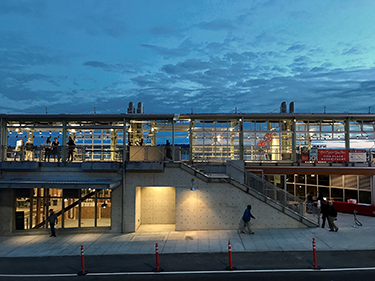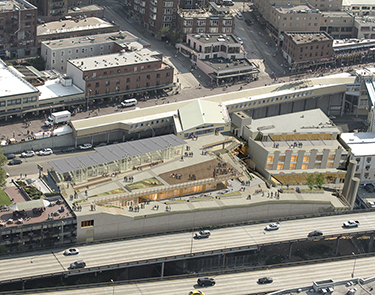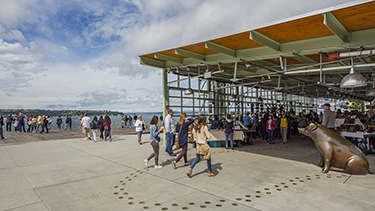|
Subscribe / Renew |
|
|
Contact Us |
|
| ► Subscribe to our Free Weekly Newsletter | |
| home | Welcome, sign in or click here to subscribe. | login |
Architecture & Engineering
| |
 |
June 29, 2017
‘This is going to be a wild ride’ for the design team
The Miller Hull Partnership

Miller
|
In early 2013 Miller Hull embarked on the amazing journey of leading a team in designing an addition to Pike Place Market.
Our challenge? To design a prominent new structure for a notable and recognizable landmark — revealing the potential of the last undeveloped parcel of Market property just south of Victor Steinbrueck Park.
As architects, the responsibility of finding an appropriate solution that links tradition and modernity was both daunting and exhilarating. From the outset our team said to ourselves, “This is going to be a wild ride!”
Though our firm got to tackle the design for the site this time, over the years numerous esteemed Seattle architects had advanced excellent ideas about how to deal with this challenging location. But in a sense, a financially viable solution has always been beyond an architect’s reach.
Interestingly, the planned demolition of the Alaskan Way Viaduct and subsequent deep bore tunnel project led to fortuitous new financial and design opportunities. State mitigation funds were allocated for a new 300-stall parking garage on the site to replace parking under the existing viaduct that will be lost when it comes down. And anticipating the removal of the viaduct prompted the city to turn its attention to reimagining the waterfront without the elevated roadway.
Without a doubt, the project required solving the most challenging range of complexities that any site has ever posed for the firm (certainly in my nearly 40 years of work as an architect).
The physical and programmatic challenges were numerous: building on a steep hillside over and around a train tunnel that cuts diagonally under the site (without being able to touch or create an additional load on the tunnel); designing a parking garage that drops four levels below Western Avenue; and providing retail space, additional vendor space and a minimum of 40 low-cost housing units.
Beyond these Market-related goals, the project was envisioned to be a major connection to the new waterfront.
Getting the vibe right
All that said, it turned out the true challenge was building consensus among stakeholders and community members for design concepts and the organization of spaces. Every cultural design project brings overlays of symbolism, heritage and mission. Pike Place Market offers culture in spades amid its mosaic of day stalls, fixed retail and restaurants, sights and sounds, and labyrinthine pathways and stairways.
The spirit of Pike Place Market is ephemeral — it is not about high architecture. In the fullest sense of the word, it is all about place. Which is why the challenge to express the intrinsic character of this landmark through architecture — in a way that does not detract or look out of place — was so great. And why it was necessary to elevate the conversation around a new building there from well-meaning but stoic resistance to change by many champions of the Market, to enthusiasm and optimism for what can be.
To address these concerns, sophisticated computer models were developed examining building massing options to review view corridors from both internal and external spaces in a range of building profiles. An overarching goal has been to meet not only the Market’s needs, but to collaborate with the city in developing a series of new public circulation and outdoor gathering spaces that will extend and enhance the Market’s role in the cityscape.
In assessing the site’s context, our design team was inspired by the industrial structures and simple materials found throughout the Market that embody the essence of what is a very utilitarian complex. The design that emerged has a strong Northwest industrial toughness, in keeping with the Pike Place Market “vibe,” yet includes large, open volumes with glass that offer transparency inside and out.
The palette of concrete and heavy timber brings the material “language” of the Market across Western and provides a familiar backdrop for an engaging new mix of small retail shops and stalls, restaurant space, underground parking, low-income housing, an incredible new public view terrace with outdoor seating currently lacking at the Market, and a pedestrian connection to a walkway that will descend from the Market and connect to the city’s central waterfront.
Waterfront connection
Pike Place Market is positioned as the central connection point to engage with the new Overlook Walk being designed by New York City firm James Corner Field Operations. The Overlook, currently in schematic design, will rise from the waterfront with an extended public space through and over the Market site to the city.
So, besides having the responsibility to design a prominent new addition to the Market, this project is now also part of the city’s effort to overhaul the entire waterfront, and to dramatically improve the connection between the water’s edge at Elliott Bay and the urban core above.
In adding to this historic hub cobbled together over the past 100 years, the respectful architectural expression of the new site enables the Market to do more of what it does best — with an updated Western front that keeps it fresh and relevant. And it has been an incredible opportunity to represent the city and Market’s interests on this major urban project that will have a positive and lasting impact on Seattle.
David Miller is a founding partner of The Miller Hull Partnership. He also is a professor in the Department of Architecture at the University of Washington.
Other Stories:
- Low-income housing joins the mix at MarketFront
- MarketFront fulfills long-held dream to reclaim site marred by fire
- New open space is the next step on a path to the waterfront
- MarketFront sits just inches above an active train tunnel: Here's how
- The story behind — and beneath — those big vent stacks





